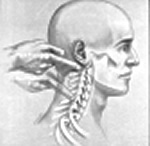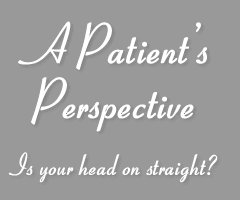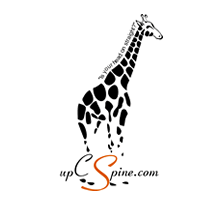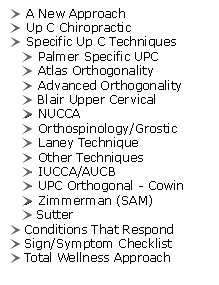Home | A New Approach | Sign / Symptom Checklist
SIGN / SYMPTOM CHECKLIST

POSTURE IS A WINDOW INTO A PERSON'S
HEALTH
Upper Cervical misalignment = Poor Posture = Poor Health
The following Signs and Symptoms may indicate
Upper Cervical (c0-c1-c2) Injury
C0 – skull or occiput; C1 – atlas; C2 - axis
These are the signs, which may indicate that you have
an upper cervical spine injury, which may have gone undetected for some
time. You don’t have to experience all of these symptoms, just some.
However, the posture, head tilt sign, shoulder height sign and ear symptoms
will, in my opinion, make it a strong possibility that you do have such
an injury.
-
Is your posture poor? Do you have rounded shoulders
and/or forward head posture? Does your head feel heavy to hold?
- Is your head tilted to one side and/or your head
rotated to one side when you look in a mirror? This can be really
subtle.
- Does your nose or nasal septum deviate to one side? If so, you
may find that it deviates towards the side to which your atlas has
moved anterior (e.g. nose deviates to the left; then atlas is anterior
on the left)
- Is one of your shoulders lower than the other?
Pull your shoulders back and down and look carefully for one lower
than the other. Again it can be subtle.
-
 Press
firmly but gently with your thumb into the impression just below your
skull at the top of your neck on both sides (see picture). This is
known as the sub-occipital area. Find the base of your skull and press
the soft flesh around that area. Is this tender or painful for you? Press
firmly but gently with your thumb into the impression just below your
skull at the top of your neck on both sides (see picture). This is
known as the sub-occipital area. Find the base of your skull and press
the soft flesh around that area. Is this tender or painful for you?
- Do you have some shoulder and/or neck pain/aches,
which don't seem to go away?
- Does your jaw click when you use it, open it to
eat etc. Further check on this; Put your pinkies (little fingers)
into your ear canals and chew normally. Do you feel a bumpy dislocation
like feeling? This should be a smooth action in your joints.
- Do you have any lower back pain or mid back pain
(under the shoulder blades) niggles?
- Can you move your head from side to side without
pain or restriction? Is there a loss of Range of Motion (ROM)?
- Do you have any sand paper, clicking or crunching
sounds when moving your head from side to side in a 'NO' action? (i.e.
cervical crepitus)
-
Is your hearing a problem or do you have other
ear symptoms (e.g. tinnitus, watery sounds, blockages, vertigo, Meniere’s
Disease, otalgia, recurrent ear infections)?
-
Do you often get headaches or migraines?
-
Can you remember any trauma (even minor) to the
head, neck or shoulders?
-
Was your birth difficult?
-
How's your vision? – Sensitive to
light, especially at dusk, floaters?
-
Do you experience any dizziness, vertigo or movement
sensations (i.e. loss of proprioception)? Does the ground seem to
move away from you?
-
Do you experience any tingling and burning sensations
especially in fingers and toes?
-
Do you have confirmed Scoliosis of the spine,
from x-rays? Do you have one leg shorter than the other or is your
pelvis higher on one side?
-
Have you had any x-rays, CT scans or MRIs taken
of your cervical spine (neck)? Do these reveal loss of cervical lordosis
(neck curve), even a small amount?
|




 Press
firmly but gently with your thumb into the impression just below your
skull at the top of your neck on both sides (see picture). This is
known as the sub-occipital area. Find the base of your skull and press
the soft flesh around that area. Is this tender or painful for you?
Press
firmly but gently with your thumb into the impression just below your
skull at the top of your neck on both sides (see picture). This is
known as the sub-occipital area. Find the base of your skull and press
the soft flesh around that area. Is this tender or painful for you?